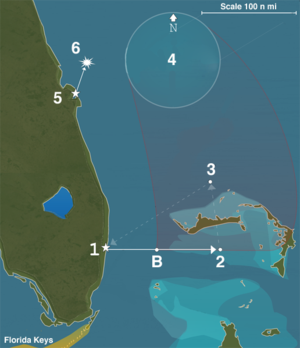

In 1950, the Associated Press published an article written by Edward Van Winkle Jones that was among the first to credit geography for a string of disappearances in the region. While many will trace the Bermuda (or Devil’s) Triangle legend back to Christopher Columbus, his accounts of his compass behaving abnormally within the Bermuda Triangle really weren’t all that unusual, and, believe it or not, the “Triangle” wasn’t even blamed for the disappearance of Flight 19 back in 1945 - why, you ask? Because the pop culture icon that would become The Bermuda Triangle hadn’t been made up yet. She thinks I’m too skeptical, but the truth is that I take a hard-line approach to these things because I want to believe - and that want motivates me to cut through the bullshit.Īnd to be honest, that’s what the legend of the Bermuda Triangle really is. My wife (an avid believer in all things that go bump in the night) and I (the kind of skeptical ass that’ll ruin your ghost story with fact checking) have navigated the nonsensical halls of the Winchester Mansion, trudged through the mud in long-vanished Civil War graveyards, and listened attentively to broken English descriptions of local legends on three different continents. Over the years, I’ve stolen every opportunity I could to sneak around spooky places and look for evidence of something beyond the veil of human understanding.

That’s me in the back, paddling my way through a bit of the Bermuda Triangle To date, I’ve traveled through different parts of the Bermuda Triangle by plane or boat of varied sizes and speeds, spent days inside its spooky perimeter, scanning the horizon for signs of trouble all along the way… only to be met with a long, boring horizon or the occasionally exciting bout of rough weather. On my way home, I decided that the Triangle either didn’t want me, or the legends of sea monsters, interdimensional vortexes and flying saucers may have been exaggerated. It wasn’t until a few years later that I’d make my first pass through the Bermuda Triangle by ship, allowing me far more time to look the monster square in the eye and see which of us would blink. I knew, rationally, that there was nothing to be afraid of… but something in me made me keep my eyes on it, as though it was only my attention that kept the monsters at bay. Still, as I peered out over the ocean from my seat high in the sky, I couldn’t help but feel a sense of death below - not in a threatening way, but more like I felt as a kid riding the school bus as we passed by the old cemetery on the far end of my neighborhood. Today, for most of us, the infamous Bermuda Triangle has become a “blink and you’ll miss it” part of normal travel - not the man-eating vortex of mystery I believed it to be as a kid. I shot across it in just a matter of minutes, thanks to modern commercial air travel.

The first few times I traversed the Bermuda Triangle were by plane, skipping over corners of the legendary stretch of sea that’s swallowed up so many sailors, aviators and tourists alike. Navy Grumman TBF-1 Avengers from Escort Scouting Squadron 29 (VGS-29) flying in formation over Norfolk, Virginia (USA), on 1 September 1942. Losing 27 men and six aircraft in a single day just off the American coast was, as time has shown, a tragedy of historic proportions - but was it also a paranormal one? Five U.S. Soon after those five aircraft and their 14 crew members had vanished, a Martin PBM Mariner flying boat was dispatched to begin the search and rescue operation - only to have the Mariner, and 13 more crew members, vanish as well. Navy torpedo bombers that disappeared without a trace somewhere in the triangle on Dec. Over the years, countless mysteries and disappearances have been associated with the triangular expanse of ocean stretching from Bermuda (as its namesake would imply) down to Miami and eastward to San Juan, Puerto Rico, though the most famous may be that of Flight 19, a group of five U.S.

(NOAA on Flickr) Related: THE SOVIET “DOME OF LIGHT” COLD WAR WEAPON MYSTERY


 0 kommentar(er)
0 kommentar(er)
